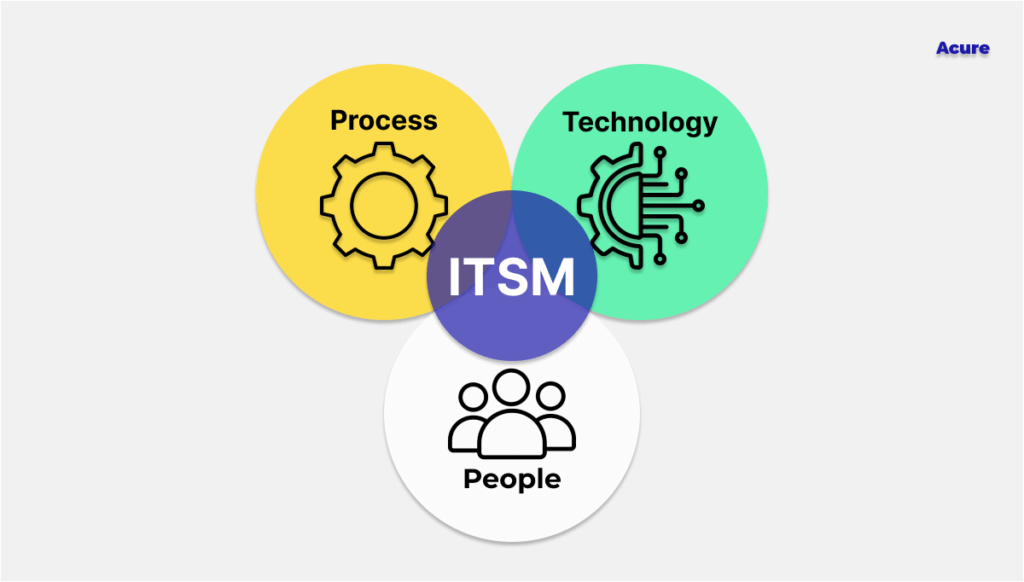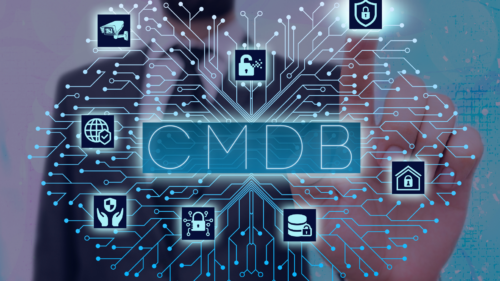What Is IT Service Management?
IT service management involves creating, designing, managing, delivering, supporting, and improving all the IT services a firm provides to its end users. IT service management (ITSM) helps a business run and grow efficiently. In other words, ITSM aligns IT services with the organization’s or business’s objectives.
For example, the laptops, software installed, and other tech devices in an office are all maintained and provided by the IT team or IT service management.
It might seem like IT service management looks after a company’s technology needs and resolves day-to-day issues, but it goes way beyond it. IT service management holds the company together, which makes workflow effortless and efficient.

ITSM effectively removes all the problems that come its way and coordinates all the tasks efficiently while ensuring they provide value to the customer. It helps and benefits the IT team, and service management policies help an organization to grow, aims to increase productivity, and through a structured approach, aligns business goals and IT on the same path. ITSM helps in getting the best out of the resources and budgets and reduces the risk factors while improving customer experience.
In simpler words, ITSM helps support IT services throughout the lifecycle thoroughly, increases the employees’ productivity, and enhances the firm’s efficiency.
Breakdown of IT Service Management
ITSM can be broken down into five categories or areas to understand the role of IT service management in a firm.
- Organization: ITSM helps a firm or a company function and performs its objectives to achieve the organization’s goals. It allows a company to perform its core functions without any hurdles.
- Services: ITSM provides hardware, software, apps, infrastructure, and other IT-related assistance that the company needs.
- Problem-Solving: IT service management ensures no hindrance in the quality of work; hence ITSM solves all IT-related issues immediately, efficiently, and effectively.
- Cost: ITSM aims to get the most out of the IT budget without causing any additional burden to the firm’s budget.
- End-User: End-users are the ones who use IT services, such as customers and employees.
These are the five essential areas of concern related to IT service management.
What Is ITIL?

Many IT professionals use ITIL and ITSM, sometimes interchanging the terms. Though they are used interchangeably, both terms have a crucial difference.
ITIL is formerly known as the “Information Technology Infrastructure Library.” It was created by the Central Computer and Telecommunications Agency (CCTA) under the backing of the UK government. ITIL is a registered trademark of the British government’s OGC (Office of Government Commerce).
ITIL was developed to define the organization’s structure and look into the skill requirements of the IT organization. In addition, it was created to introduce standard operational management practices and procedures for an organization to manage an IT operation.
In simpler words, ITIL is a framework of all the best recommendations and practices for managing a firm’s IT services and operations for the firm’s improvement. It provides a set of guidelines for efficient and effective IT service management.
Difference between ITSM and ITIL
As mentioned above, there is a critical difference between ITSM and ITIL. ITSM is a model or a paradigm, whereas ITIL is a framework of best practices.
IT Service Management
ITSM is a model for understanding the relationship between an IT organization and the firm it supports in a specific way. ITSM paradigm helps IT firms focus on managing all their services and delivering services to the business the firm supports.
IT Service Management model can be summarized as follows:
- The function or goal of an IT organization is to provide services to the firm.
- All the services provided must align and help accomplish all the goals and needs of the company.
- The services provided must be managed thoroughly and throughout their entire lifecycle.
- The IT sector or department is its organization, whereas the business is its customer.
ITIL
While ITSM defines the relationship between the business and IT organization, ITIL is more than that. ITIL is a framework that helps manage IT services throughout the service lifecycle effectively and efficiently.
ITIL is a collection of values, strategies, and processes that will assist in executing ITSM. There are other ITSM frameworks, but ITIL is popular and most used.
📈 The Benefits of IT Service Management
There are various benefits of implementing IT service management in the company. The company size does not matter while implementing and investing in an IT service management process.
The benefits of investing in or implementing IT service management processes can be divided into two categories: Benefits for Business and Benefits for IT.
Benefits for Business

- It reduces the number of incidents in and around the business. It reduces the impact of the incident as well.
- ITSM provides the best services at a lesser cost.
- The ITSM will have an advanced understanding of the goals and needs of the company. It will help the company reach its goals effectively.
- IT service management will handle and deliver the expectations of the company in a better manner.
- The employees of a firm or an organization will be able to finish more work with good IT performance and availability.
- The employees will be able to understand how to use the services and have more knowledge regarding all the services available.
- If there is a change in the market, the IT service management can and will react to the change and innovation quickly.
Benefits for IT

- There will be an increase in IT productivity and efficiency. This is because there will be designated roles and responsibilities for everyone.
- There will be a prevention of IT-related issues before the issue occurs.
- IT’s performance can be improved when ITSM is implemented.
- If there are repeated problems and challenges, it will be easier to identify and counter them.
- The process of identifying and solving problems will take place in a shorter duration.
- It is a scalable and repeatable process.
⚙️IT Service Management Processes
Here are a few core ITSM processes:
Service Request Management
Service request management is the procedure of handling, managing, and following up on customer service requests. These requests include hardware updates, password resets, access to applications, updating personal information or data, or updating software.
Service request management helps in looking after important requests and ensuring that the requests are solved. The request management workstream involves solving recurring requests.
Incident Management
Incident management means tracking and responding to unplanned situations. Incident management also looks after service requests for new hardware, software, and other services.
In addition, ITSM looks into solving the incident as soon as possible to restore the service to the customer. Incident management prioritizes incidents and requests according to their impact on the business.

Problem Management
Problem management is the process where the incidents are identified and managed. The method also involves checking the cause of the incident. During this process, The root cause of the incident is understood and analyzed.
Then, the underlying cause of the incident is looked into and eradicated with best practices. Problem management eliminates recurring incidents as well while removing defects.
Service-level Management
Service-level management is where service-level commitments from vendors and customers are tracked. This helps in understanding the weaknesses and taking action to correct them.
Change Management
Change management is the process where all the changes in the IT infrastructure are handled efficiently. The changes can be introducing new services, resolving problems in the code, and taking care of existing services.
Quick and effective change management helps decrease risk and creates space for transparency to avoid workflow stoppage.

Workflow and Talent Management
Workflow and talent management means the process where the people with appropriate skills and knowledge are placed in the roles that suit them best. This process helps achieve business goals and objectives as employees with the right talent and skills are placed in the best position for them.
Continual Improvement Management
Continual improvement management implements tasks to track performance and measure success. This process helps in the improvement of the company and all its services.
Configuration Management
Configuration management is tracking all configured items in the IT system. The important configured information for software, hardware, documentation, and personnel are identified, verified, and maintained during this process.
This process gives IT teams a hold of all the IT-related information. In addition, it helps establish an evident bond between services and IT infrastructure components.
🔧 What Is an IT Service Management Tool?
An ITSM tool is software that is used to deliver IT-related services. The software can be standalone or a package of applications consisting of various apps to perform functions related to IT service management.
The tool can perform various actions and functions, such as problem management, change management, and others. There is a popular term named service desk that is related to ITSM. A service desk is an ITSM tool. The tool functions as a single point of contact between the service provider and the customers. The customers can be internal or external.
The service desk constantly helps customers when the services are down and monitors all the services. The service desk also handles software licensing, service requests, incident management, and many other activities.

Points to Consider While Selecting an ITSM Tool
Many ITSM tools are available in the market. These tools help align the business goals and objectives with the IT team. It gives a strategic approach to the firm and helps in the growth of the business.
While selecting an ITSM tool or software, there are a few pointers you must keep in mind. These pointers are essential as ITSM tools and software play a huge role in the firm’s functioning.
- Accessible to Use: The tools must be user-friendly. ITSM is created and designed to provide IT services throughout the organization. If it is hard to use, the employees can have trouble understanding how to use the tool or software efficiently. The tool should have a portal to help users find information and solutions. The tool should also help in tracking progress on issues.
- Easy to Setup: Setting up the tool should be simple. If it has a complicated setup process, this can lead to a barrier while trying to adapt to the tool. The tool must come with instructions and support agents.
- Flexibility and Adaptability: Needs keep changing in the business, and many changes also occur. The ITSM tool or software must be flexible and adaptable to all the changes. The tools must be able to grow with the business and accommodate space for new growth. It should provide value to an evolving IT team.
- Collaborations: The tool or software must be able to handle and facilitate teamwork. This means that the tool must be able to provide a space for inter-departmental coordination. For example, the ITSM tool should provide a platform for developers and other teams across the organization to work together efficiently.
Wrapping Up
IT service management changes the relationship between the business and IT. It enables employees to increase their productivity, reduces the number of IT incidents, eradicates all recurring problems increases the speed and effectiveness of IT services.
ITSM effectively removes all the problems that come its way and coordinates all the tasks efficiently while ensuring they provide value to the customer. It helps and benefits the IT team, and service management policies help an organization to grow, aims to increase productivity, and through a structured approach, aligns business goals and IT on the same path. ITSM helps in getting the best out of the resources and budgets and reduces the risk factors while improving customer experience.
In simpler words, ITSM helps support IT services throughout the lifecycle thoroughly, increases the employees’ productivity, and enhances the firm’s efficiency.
Implementing IT service management in a company will be beneficial as it will be a long-term investment. The critical factor is choosing the right tool or software to align with the firm’s needs and goals. Furthermore, in the future, ITSM will integrate with AI technologies. This means that investing in ITSM will be even more beneficial.





